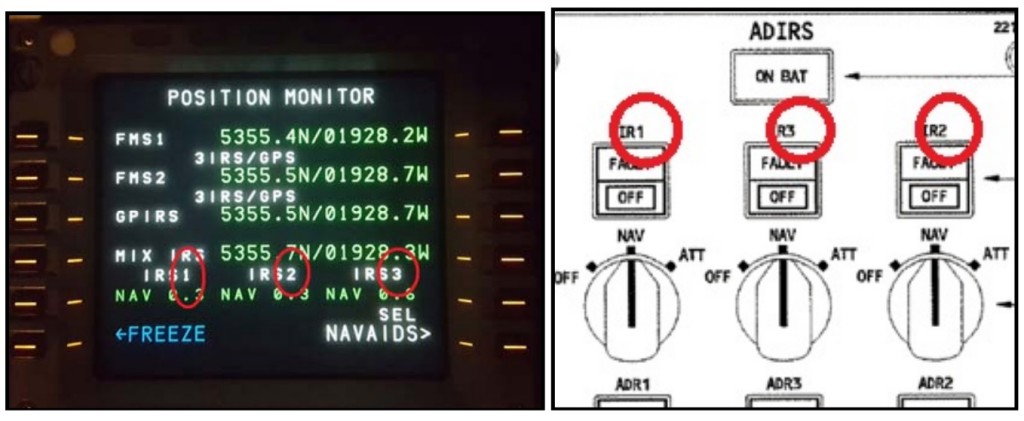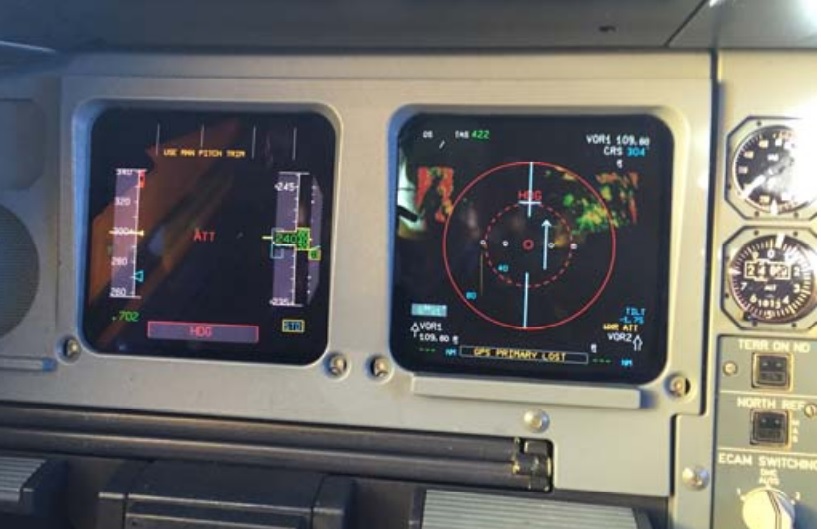Improvised Troubleshooting After Cascading A330 Avionics Problems
On 26 December 2014 XL Airways Airbus A330-243 F-GRSQ suffered a cascading series of failures over the Mediterranean on a flight from Reunion to Marseilles. The aircraft was at FL380, 280nm south of Athens, when the crew lost all three Inertial Reference Systems (IRS). This resulted in a decision to divert to Athens, where the aircraft landed safely.
History of the Flight
The safety investigation body the BEA say in their report (issued in French only), that shortly after takeoff the flight crew identified that IRS 2 was drifting. They continued to monitor this drift which varied 6 and 15nm, which in itself was not a problem. About 5 hours into the flight however, IRS3 was switched from ‘navigation’ to ‘attitude’ mode (most likely by the flight crew say the BEA, though the crew do not recall doing that and the FDR does not record the switch position). The IRS3 data was rejected by the Flight Management Guidance and Envelope Computer (FMGEC), two of which make up the Honeywell Flight Management System (FMS). However the system does not notify the crew of this. Consequently, only IRS 1 and the drifting IRS 2 data continued to be used. Two hours later, the autopilot (AP) and autothrottle (ATHR) disconnected. The BEA believe this was due to the misalignment between IRS 1 and IRS2, Consequentially, as programmed, the FMS removed the position and navigation data from the Navigation Display (ND).
The flight crew were able to retrieve the data by activating the navigation back-up mode. However, position information on the left hand side displays was lost during “uncoordinated and improvised” troubleshooting. While the BEA had FDR data, the CVR data had been over written by recording of the later part of the flight. The BEA believe that the flight crew triggered an in-flight alignment of the three IRSs which, in turn, resulted in a transition of the A330 to direct flight-control law. The BEA say the following factors were considered for the “non-standard crew actions” but “without it being possible to specify their degree of contribution”:
- Limited flight crew exposure to IRS failure situations.
- The ergonomics of the Air Data Inertial Reference System (ADIRS) control panel not visually show the irreversible nature of the IRS mode changes
- The logic of information presentation on the Electronic Centralized Aircraft Monitor (ECAM) which did not articulate the reason for the AP disconnection
- The presentation of the IRS information on the POSITION MONITOR page of the Multi-Function Control and Display Unit (MCDU) in numerical order (1,2,3) differed from the rotary switch arrangement (1,3,2), which is representative of the architecture system (see the BEA images below).
 Only one event with similar consequences was found in Airbus’ database (an A320 in 2002).
Only one event with similar consequences was found in Airbus’ database (an A320 in 2002).
Previous Maintenance
The BEA say that that IRS 2 had been reported as drifting on previous flights. IRS 2 was to replaced on 24 December 2014 in Marseilles. However, due to erroneous Functional Identification Number (FIN) tags in the avionics bay, IRS 1 was replaced instead. The reason for the mislabelling could not be established. The BEA could confirm no maintenance in this area since 2007 (no relevant technical records were available from the time of delivery in 2002 to 2007). No mislabelling was found in a subsequent fleet check of XL’s two other A330s.
Safety Actions
The BEA report that Airbus undertook to update their documentation to incorporate the use of the NAV BACK-UP mode in all cases resulting in the loss of ND positions. F-GRSQ was equipped with Honeywell P3 FMS standard (as is 40 to 45% of the long-haul Airbus fleet). The newer Honeywell P4 standard includes a modification that allows for better availability of position data in this type of situation.
Safety Resources
You might find these past Aerossurance articles interesting:
- Confusion of Compelling, But Erroneous, PC-12 Synthetic Vision Display
- AAIB: Human Factors and the Identification of Saab 2000 Flight Control Malfunctions
- HF Lessons from an AS365N3+ Gear Up Landing
- Challenge Assumptions: ATSB on A330 with a u/s GPS
- When Screens Go Blank: NTSB on a 787 Display Loss After a Lightning Strike
- UPDATE 11 August 2018: Investigation into Jet Airways B777 VT-JEK Serious Incident at Heathrow Due to errors in performance calculation the aircraft departed from an intersection with thrust set for a full runway length take off.
- UPDATE 13 January 2019: Human Factors of the Selection of Parking Brake Instead of Speed Brake During a Hectic Approach (ERJ145 at Runway Excursion at Bristol)
- UPDATE 17 March 2019: Easyjet A320 Flap / Landing Gear Mis-selections
Also: UPDATE 8 August 2018: Digital alerts under scrutiny after A320 incident: The Australian Transport Safety Bureau (ATSB) has revealed they are examining how aircraft system alerts are prioritised and presented on A320 after a 12 September 2015 incident involving Virgin Australia Regional Airlines’ VH-FNP.


Recent Comments